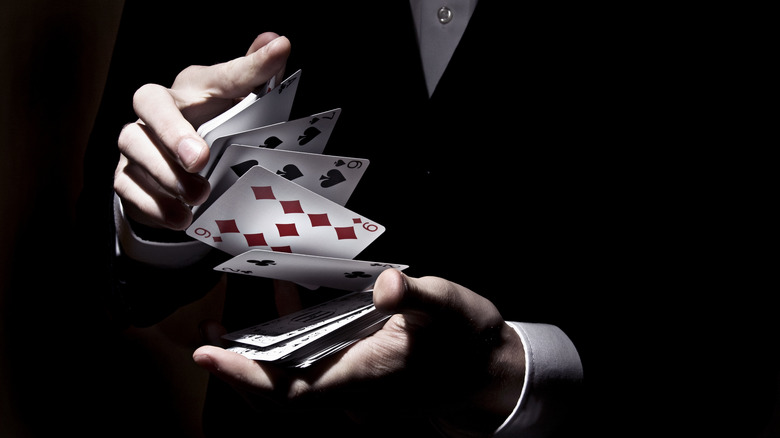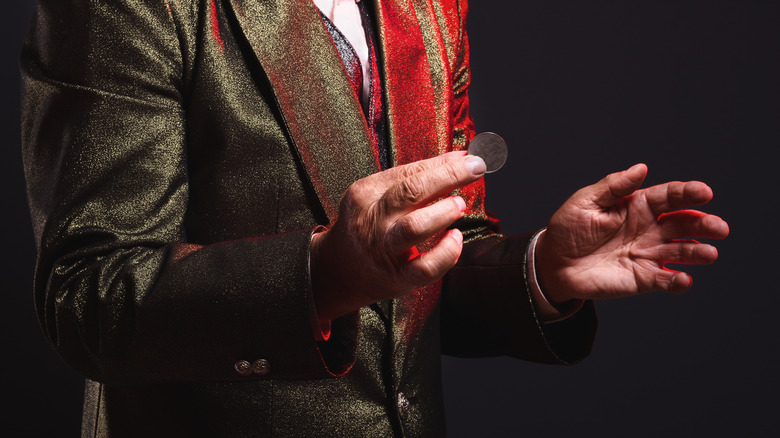How Magicians Exploit Your Brain
We may receive a commission on purchases made from links.
Magicians have been around since ancient times. In fact, the first known magic act was back in 2,700 B.C. by a magician called Dedi, whose tricks involved balls and cups, as well as decapitating birds and bringing them back from the dead, per CW Magic. Tricks have evolved throughout the centuries, and people of all ages remain fascinated and entertained by magic. As adults, we know that a person isn't really being cut in half, or that a rabbit can't just be pulled out of a hat, and still, we are drawn to it.
Throughout the years, more research and studies are conducted about understanding magic and how people perceive it. The psychology department at the University of London has a laboratory — The Magic Lab — solely for studying magic. Dr. Gustav Kuhn, the head of the lab, said that we tend to gravitate toward things that we don't understand, and that includes magic tricks. According to Wired, Kuhn also stated that magic and psychology go hand-in-hand, and magicians exploit how the human brain operates. "To be a good magician you really need to understand how the brain works," he said.
Single-mindedness
As reported by the Princeton University Press, the average adult human brain runs on approximately 12 watts of power. In comparison, a laptop runs on about 60 watts. Because of that limit, humans are naturally single-minded, which means that we tend to focus on only one thing at a time, and that is what magicians exploit when they perform sleight-of-hand tricks, such as making objects vanish or taking an item from your person without you noticing.
Our brains make use of two ways to process stimuli: top-down and bottom-up. In top-down, the brain processes information from the stimulus based on what we already know. The brain forms inferences based on knowledge that is already stored. Bottom-up, on the other hand, is the processing of information through senses (via Psychreg). Knowing this, magicians can effectively perform sleight-of-hand tricks using distractions to occupy the brain. Top-down distractions include getting the audience's attention by conversing or doing actions, and bottom-up distractions are sudden movements, noises, and other actions that stimulate the senses. The sleight-of-hand trick is then performed while the audience's attention is somewhere else, as reported by Live Science.
University of Utah psychologist David Strayer that realistically speaking, multitasking is not possible, as we are "serial processors." "When we try and multitask, we're just switching from one activity to another," he stated. So, it may seem that you are focused on all the things that are going on during a magic trick, but in reality, there are several things happening and the brain can only focus on one thing at a time.
Psychological misdirection
Psychological misdirection is another tool that magicians use to perform tricks. A magician makes the audience believe that they know what's coming next and then performs the unexpected. As noted by Master Class, misdirection is the art of manipulating the audience to put their focus on one thing, so that how the trick is executed remains a secret. It's important to note that misdirection is not just distracting the audience; it's the art of making the audience not notice that they are being distracted.
Magicians exploit the brain's limited attention. Per Psychology Today, the brain isn't able to focus on several things happening at the same time. A magician deliberately draws the crowd's attention to give them the opportunity to execute a trick away from the crowd's eyes. A simple example of this is the vanishing ball trick wherein a magician tosses a ball a few times into the air. Spectators will typically follow the ball's movement up and down — just as the magician does — and on the final toss, the ball seemingly disappears into the air (per Spring). In reality, the magician hides the ball behind the palm on the final toss while looking upward to misdirect the audience.
Cognitive illusions
According to an article on Spring, it takes about one-tenth of a second for information to get to the brain. In that time, the brain is automatically predicting what will happen. Magicians take advantage of cognitive illusions to perform tricks. As noted by Scientific American, cognitive illusions deal with memory, attention, and inference. One of the most basic tricks involve passing a coin from one hand to the other and then disappears. The audience automatically predicts the movement of the coin, and when the magician palms it stealthily, it's an unexpected move.
Dr. Gustav Kuhn and his associates conducted a study on perception and why we don't easily spot when changes happen, such as in the coin trick. The results of the study revealed that it isn't because the eyes are not looking closely at what happens, but because the audience's attention is elsewhere. Experts have discovered that what we look at and what we pay attention to may be different things, and one of the reasons the coin trick may be so effective is because even if the crowd has their eyes directed toward the hand where the coin disappears, their attention may be focused on something else entirely.
Power of suggestion
The power of suggestion is present in our everyday lives, and magicians use it to perform tricks as well. Some of the examples of how they plant an idea in the audience's mind are by saying certain words, doing specific hand gestures, or creating a setting that will influence the way people think. However, the trick is to make the audience believe they have free will, as noted by Magic Mentalism. One example of how magicians use the power of suggestion is when doing card tricks, such as seen in this simple video that features illusionist Derren Brown.
In it, he asks the viewers to choose a card, and the majority will choose the three of diamonds, which is the same card that he reveals at the end of the video. Upon watching the clip again, however, one can see that Brown used the power of suggestion to influence the viewers' decisions. First, he says to choose a bright color, and the apparent choice is red. Then, as he talks, he forms a diamond using his hands, and while asking to choose a number, he draws the number "3" several times in the air while speaking. All of the actions happen so fast, that it isn't obvious that he is using the power of suggestion while making the viewers think that they have free will.
Inattentional blindness
Inattentional blindness is a phenomenon wherein people do not recognize something that happens or appears right in front of them due to the presence of several visual stimuli. One of the most popular studies of inattentional blindness is the invisible gorilla test. In it, test subjects were instructed to take note of the number of times the players wearing white shirts pass a basketball to one another. The video shows three people wearing white, and three people wearing black. There are two basketballs being tossed around. In the middle of the video, a person in a gorilla suit enters the scene, stops in the middle of the players, beats his chest, and exits the scene.
The test subjects were then asked if they noticed something odd in the video. As reported by Verywell Mind, about 50 percent of them said that they didn't notice anything unusual. This is because they were focused on the people with white shirts and concentrating on them passing the ball. Magicians exploit this phenomenon when performing tricks, and the audience remains "blind" to how the trick was done while they have their attention on something else the magician is doing.





